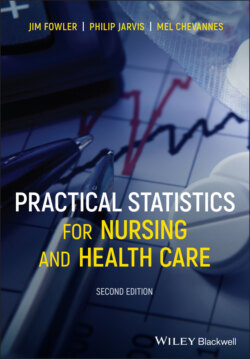Читать книгу Practical Statistics for Nursing and Health Care - Jim Fowler - Страница 11
Оглавление1 Introduction
1.1 What Do we Mean by Statistics?
Statistics are a familiar and accepted part of the modern world, and already intrude into the life of every nurse and health care worker. We have statistics in the form of patients registered at a GP practice or outpatient clinic; hospital measurements and records of weight, temperature, blood pressure and pulse rate; data collected from various surveys, censuses and clinical trials. It is impossible to imagine life without some form of statistical information being readily at hand.
The word statistics is used in two senses. It refers to collections of quantitative information, and methods of handling that sort of data. A hospital's database listing the names, addresses and medical history records of all its registered patients, is an example of the first sense in which the word is used. Statistics also refers to the drawing of inferences about large groups on the basis of observations made on smaller ones. Estimating the relationship between smoking and the incidence of lung cancer illustrates the second sense in which the word is used.
Statistics looks at ways of organizing, summarizing and describing quantifiable data, and methods of drawing inferences and generalizing upon them.
1.2 Why Is Statistics Necessary?
There are two reasons why some knowledge of statistics is an important part of the competence of health care workers. First, statistical literacy is necessary if they are to read and evaluate reports and other literature critically and intelligently. Statements like ‘the reduction in mean number of migraine days was 3.5 (SD 2.5) for manual versus 2.4 (3.4) for sham (adjusted difference −1.4, 95% confidence interval −2.4 to −0.3; P = 0.005) at weeks 13 to 16’ (Xu et al. 2020), enable the reader to decide the justification of the claims made by the particular author.
A second reason why statistical literacy is important to health care workers is if they are going to undertake an investigation that involves the collection, processing and analysis of data on their own account. If the results are to be presented in a form that will be authoritative, then a grasp of statistical principles and methods is essential. Indeed, a programme of work should be planned anticipating the statistical methods that are appropriate to the eventual analysis of the data. Attaching some statistical treatment as an afterthought to make a survey seem more ‘respectable’ is unlikely to be convincing.
1.3 The Limitations of Statistics
Statistics can help an investigator describe data, design experiments, and test hunches about relationships between things or events of interest. Statistics is a tool that helps acceptance or rejection of the hunches within recognized degrees of confidence. They help to answer questions like, ‘If my assertion is challenged, can I offer a reasonable defence?’
It should be noted that statistics never prove anything. Rather, they indicate the likelihood of the results of an investigation being the product of chance.
1.4 Performing Statistical Calculations
Today there is an abundance of internet sites and free statistical software packages that are capable of performing all the statistical analyses described in this book. However, we suggest caution against jumping straight into using these programs and internet sites without first understanding the underlying background and principles of a particular statistical technique. These tools can perform any analysis that you ask of them, but cannot provide the intelligent reasoning about whether the test is appropriate for the kind of data you are using. Moreover, a ‘screen shot’ of the analysis can be ambiguous and confusing if you do not understand the underlying principles. We feel this is best achieved by first familiarizing yourself with the techniques ‘long hand’, using a simple spreadsheet package working through our own examples and applying them to your own data. When using any statistical software for the first time it is best practice to ensure that you are able to replicate text book examples to check that you are using the program correctly and that the software is working correctly. All the calculations and worked examples in this book were performed using the LibreOffice 6.3.3.2 downloaded from https://www.libreoffice.org.
1.5 The Purpose of this Text
The objectives of this text stem from the points made in Section 1.2. First, the text aims to provide nurses and health care workers with sufficient grounding in statistical principles and methods to enable them to understand and assess the significance of survey reports, journals and other literature. Secondly, the text aims to present them with a variety of the most appropriate statistical tests for their problems. Thirdly, guidance is offered on ways of presenting the statistical analyses, once completed.
Full details of references and other material that we suggest for further reading are listed in the Bibliography. For assistance in cross‐referencing, we classify items according to chapter. Thus, Section 9.1, Figure 9.1, Table 9.1 and Example 9.1 are all to be found in Chapter 9.
